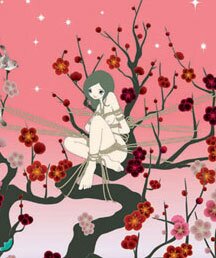Banding Together
Posted by ben on 16 Feb 2007 at 01:09 am | Tagged as: responses/reviews
 Over at his blog on Glasstire, Bill Davenport takes a stab a pinning down the allure of art corporations like Kaikai Kiki (corporate home of Chiho Aoshima, who recently anthropomorphized half the buildings in downtown San Antonio in her Artpace installation). His conclusion is that, apart from the marketing benefits, perhaps these institutions provide artists with a fortress to protect them from constant calls for innovation. If the corporation is seen as innovative, then the artists can just work within the stylistic language which has become its signature. They can refine rather than innovate. Perhaps it goes back to the traditional artistic families in Japan, with their domination of certain art forms and their rigid allegiance to tradition.
Over at his blog on Glasstire, Bill Davenport takes a stab a pinning down the allure of art corporations like Kaikai Kiki (corporate home of Chiho Aoshima, who recently anthropomorphized half the buildings in downtown San Antonio in her Artpace installation). His conclusion is that, apart from the marketing benefits, perhaps these institutions provide artists with a fortress to protect them from constant calls for innovation. If the corporation is seen as innovative, then the artists can just work within the stylistic language which has become its signature. They can refine rather than innovate. Perhaps it goes back to the traditional artistic families in Japan, with their domination of certain art forms and their rigid allegiance to tradition.
While I agree with him about the harmful effects of forced innovation, I don’t see why he’s so quick to dismiss the idea that banding together in this way can help artists pioneer new forms. Despite the tendency of institutions to become conservative to the point of sluggishness, well-run corporations have learned to spur innovation in many areas. Although I don’t know much about Kaikai Kiki, it seems to function in a way that is very similar to a record label, discovering, cultivating, producing, and promoting young artists, often with heavy merchandising. In some cases, by bringing groups together under a single imprint, labels are able to cultivate a market for a burgeoning artistic style. Under the right circumstances, this can lead artists to push the limits of the style further, as the audience expands to meet them.
I know the opposite is more often the case — but I wouldn’t be so quick to dismiss the notion that a corporate setting has the potential to encourage innovation.
rainbird
User
Monster truck
Re: Art before psychoanalysis – 2006/09/19 19:38 It hurts more than you’ll ever know that, try as I might, I don’t speak your language.
* I recognize your voice though.
Post edited by: rainbird, at: 2007/03/31